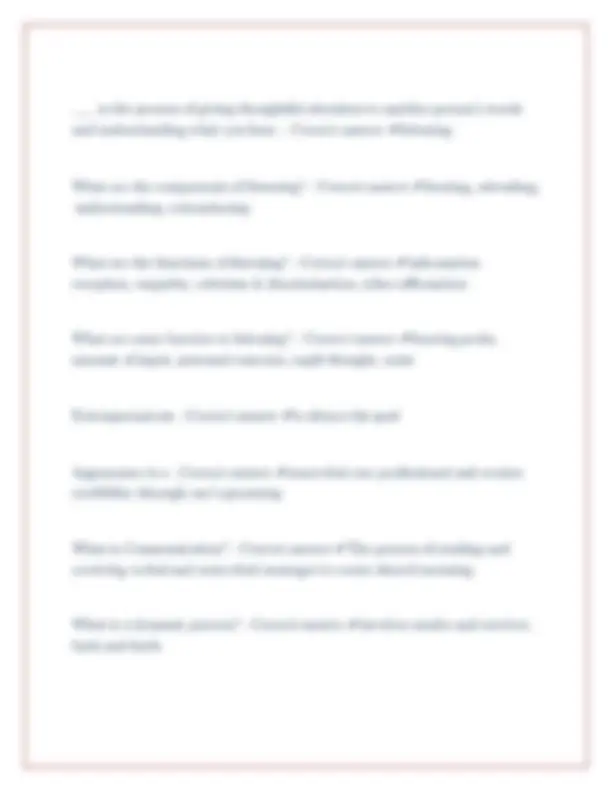









Study with the several resources on Docsity

Earn points by helping other students or get them with a premium plan


Prepare for your exams
Study with the several resources on Docsity

Earn points to download
Earn points by helping other students or get them with a premium plan
Community
Ask the community for help and clear up your study doubts
Discover the best universities in your country according to Docsity users
Free resources
Download our free guides on studying techniques, anxiety management strategies, and thesis advice from Docsity tutors
A series of questions and answers related to public speaking, covering topics such as verbal and nonverbal communication, delivery styles, audience analysis, and the structure of a speech. It also touches on the principles of nonverbal communication, proxemics, chronemics, paralanguage, and vocal quality. The document further explores the elements of language and style, including appropriateness, clarity, and vividness, as well as the importance of listening skills and overcoming communication apprehension. It serves as a concise review of key concepts in communication studies, particularly for exam preparation or quick reference. Useful for students studying communication, rhetoric, or public speaking, providing a structured overview of essential topics and concepts. It is designed to help students review and reinforce their understanding of key principles and theories in the field of communication.
Typology: Exams
1 / 13

This page cannot be seen from the preview
Don't miss anything!








A | _____ | message | consists | of | the | words | that | we | use | and | a | _____ | message | consists | of | everything | else. | - | Correct | answer | ✔verbal; | nonverbal What | is | the | word | for | the | fear | of | public | speaking? | - | Correct | answer | ✔glossophobia Systematic | desensitization | - | Correct | answer | ✔the | process | of | reducing | sensitivity | by | exposure Put | these | in | order | and | which | is | our | end | goal? Conscious | incompetence, | unconscious | competence, | conscious | competence, | unconscious | incompetence | - | Correct | answer | ✔1. | Unconscious | incompetence- | not | okay!
What | are | the | 4 | methods/styles | of | delivery | and | what | is | each? | - | Correct | answer | ✔1. | impromptu- | speaking | w/limited | preparation, | 2. | manuscript- | speaking | from | a | fully | written | manuscript, | 3. | memorized- | speaking | a | full | manuscript | from | memory, | 4. | extemporaneous- | speaking | from | an | outline | after | careful | research | and | preparation What | are | the | 4 | things | to | consider | before | delivering | a | speech? | - | Correct | answer | ✔the | audience, | if | it | demonstrates | good | content, | if | it | has | clear | structure, | if | we | are | delivering | it | effectively What | type | of | delivery | is | defined | as | considering | who | the | audience | members | are | and | taking | into | account | their | needs, | values, | and | attitudes? | - | Correct | answer | ✔audience-centered | delivery What | is | macro | structure | in | a | speech? | - | Correct | answer | ✔intro, | body, | conclusion What | are | the | Principles | of | Nonverbal | Communication? | - | Correct | answer | ✔1. | its | inevitable, | 2. | its | culturally | & | situationally | bound, | 3. | nonverbal | cues | are | believed, | 4. | nonverbal | cues | are | seldom | isolated. | 5. | 67-93% | nonverbal | communication What | is | defined | as | the | way | in | which | space | and | distance | communicate? | - | Correct | answer | ✔proxemics What | is | defined | as | the | meanings | that | we | attach | to | time? | - | Correct | answer | ✔chronemics
_____ | & | _____ | can | increase | understanding, | foster | inclusion, | arouse | emotion, | and | boost | confidence. | - | Correct | answer | ✔appropriateness | and | clarity Language | is | _____ | & | _____. | - | Correct | answer | ✔symbolic | and | arbitrary What | are | the | 3 | parts | of | the | Semantic | Triangle | from | Ogden | & | Richards? | - | Correct | answer | ✔term/concept/thing What | are | the | 9 | things | to | do | to | ensure | appropriateness | and | clarity? | - | Correct | answer | ✔1. | strive | for | accuracy, | 2. | use | words | correctly, | 3. | use | standard | english, | 4. | be | specific | and | concrete, | 5. | ?, | 6. | be | respectful | and | inclusive, | 7. | have | verbal | immediacy, | 8. | have | an | appropriate | level | of | formality | for | the | occasion, |
_____ | is | the | process | of | giving | thoughtful | attention | to | another | person's | words | and | understanding | what | you | hear. | - | Correct | answer | ✔listening What | are | the | components | of | listening? | - | Correct | answer | ✔hearing, | attending, | understanding, | remembering What | are | the | functions | of | listening? | - | Correct | answer | ✔information | reception, | empathy, | criticism | & | discrimination, | other-affirmation What | are | some | barriers | to | listening? | - | Correct | answer | ✔hearing | probs, | amount | of | input, | personal | concerns, | rapid | thought, | noise Extemporaneous | - | Correct | answer | ✔is | always | the | goal Appearance | is | a | - | Correct | answer | ✔nonverbal | cue; | professional | and | creates | credibility | through | one's | grooming What | is | Communication? | - | Correct | answer | ✔The | process | of | sending | and | receiving | verbal | and | nonverbal | messages | to | create | shared | meaning. What | is | a | dynamic | process? | - | Correct | answer | ✔involves | sender | and | receiver, | back | and | forth
Mass | Communication | Context | - | Correct | answer | ✔communication | produced | and | transmitted | via | media | to | large | audiences What | is | Communication | Apprehension? | - | Correct | answer | ✔the | fear | or | anxiety | associated | with | real | or | anticipated | communication | with | others state= | some | situations trait= | all | situation What | is | Cognitive | Restructuring? | - | Correct | answer | ✔think | about | something | differently; | could | there | be | something | that | is | your | basis | for | fear What | are | the | canons | of | rhetoric? | - | Correct | answer | ✔five | parts | of | speech | as | divided | by | Cicero | invention, | arrangement, | style, | memory, | delivery. Purpose | of | informative | speech | - | Correct | answer | ✔provides | an | audience | with | new | information, | insights, | or | ways | of | thinking | about | a | topic; | increases | awareness Purpose | of | persuasive | speech | - | Correct | answer | ✔intends | to | influence | the | attitudes, | beliefs, | values, | or | acts | of | others Purpose | of | special | occasion | speech | - | Correct | answer | ✔marks | a | special | event, | such | as | a | wedding, | funeral, | commencement, | or | banquet
Ethos | - | Correct | answer | ✔Greek | for | "character", | origin | of | ethics Reckless | disregard | for | the | truth | - | Correct | answer | ✔speaking | lies | on | purpose Hate | speech | - | Correct | answer | ✔any | offensive | communication | directed | against | race, | ethnicity, | etc Common | knowledge | - | Correct | answer | ✔info | that | is | likely | to | be | known | by | many | people Pitch | is | the | - | Correct | answer | ✔highness | and | lowness | of | your | voice In | the | intro | get | attention | with: | - | Correct | answer | ✔Question- | direct | or | rhetorical | Quotation | Story | Startling | fact | or | statistics | Action | Humor Establish | Credibility | - | Correct | answer | ✔Why | should | they | listen | to | you? | What | makes | you | know | what | you're | talking | about?
Pandering | - | Correct | answer | ✔abandoning | our | own | convictions | to | cater | to | the | whims | of | the | audience. Pseudo | listening | - | Correct | answer | ✔an | imitation | of | the | real | thing Defensive | listening | - | Correct | answer | ✔taking | innocent | comments | as | personal | attacks Semantic | triangle | - | Correct | answer | ✔To | indicate | the | direct | relationship | between | symbols | (words) | and | thoughts, | they | created | their | model. | Just | picture | a | triangle | with | the | word | symbol | at | one | peak, | thought | at | "the | second", | and | referent | at | the | third | peak. | Thought | refers | to | the | words | we | use | as | we | think | about | the | symbol, | and | the | word | referent | refers | to | the | image | we | create | in | our | minds | as | a | result | of | the | symbol. skills | building | - | Correct | answer | ✔the | more | practice/experience | the | better stage | hogging | - | Correct | answer | ✔people | are | interested | only | in | expressing | their | ideas | and | don't | care | about | what | anyone | else | has | to | say pseudolistening | - | Correct | answer | ✔pretending | to | listen | (fake | listening) what | are | the | types | of | listening? | - | Correct | answer | ✔discriminative, | comprehensive, | appreciative, | empathetic, | critical
when | a | person | feels | anxious | about | speaking | in | most | situations | whether | it | is | one-on-one | or | in | front | of | a | group | of | people | - | Correct | answer | ✔traitlike | communication | apprehension when | a | person | is | anxious | about | speaking | in | front | of | a | certain | group | (ex: | classmates) | or | a | person | (ex: | boss) | - | Correct | answer | ✔audience-based | communication | apprehension a | short-lived | anxiety | that | occurs | during | a | specific | encounter | (ex: | interviews, | speaking | to | a | professor, | speaking | to | a | significant | other | about | a | situation) | - | Correct | answer | ✔situational | communication | apprehension when | a | person | is | anxious | whenever | he | or | she | has | to | speak | in | a | particular | setting | (ex: | public | speaking, | meetings) | - | Correct | answer | ✔context-based | communication | apprehension when | we | listen | for | the | hidden | meaning | - | Correct | answer | ✔discriminative | listening when | we | listen | in | order | to | understand; | purpose | is | to | gain | and | retain | knowledge | - | Correct | answer | ✔comprehensive | listening listening | for | pure | enjoyment | - | Correct | answer | ✔appreciative | listening when | we | listen | to | someone | else's | problem | or | situation | in | order | to | lend | support | not | advice | - | Correct | answer | ✔empathetic | listening
when | we | listen | carefully | and | collect | info | that | we | then | use | to | attack | the | speaker | later | - | Correct | answer | ✔ambushing when | we | don't | receive | another's | messages | clearly | because | we | aren't | able | to | look | beyond | words/behavior | to | understand | hidden | messages | - | Correct | answer | ✔insensitive | listening what | do | we | critique | in | speakers? | - | Correct | answer | ✔content, | structure, | delivery